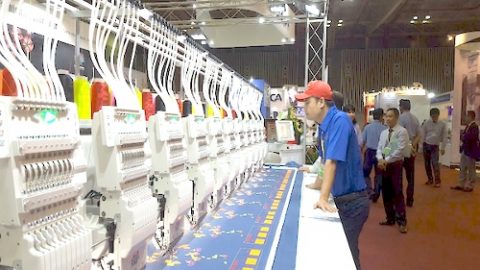
Many Vietnamese businesses are strengthening technical and digital cooperation with Korean businesses to improve production and make the most of the EU-Vietnam Free Trade Agreement.
Vietnamese enterprises are strengthening technical and digital cooperation with Korean businesses to improve production and take advantage of opportunities from EVFTA.
Mr. Vu Duc Giang – Chairman of The Vietnam Textile and Apparel Association has affirmed that, speeding up and innovating is being considered as two factors that create the foundation for Vietnam textile industry to develop.
Acceleration and innovation are fundamental
Perhaps, this also partly explains the activeness of textile enterprises when choosing to cooperate with partners with high production technology in developed textile and garment markets.
As one of the largest and most modern textile fabric manufacturers in Nam Dinh province in recent years, Bao Minh Textile Joint Stock Company has applied advanced technologies in the design and manufacture of many mid-range fabrics to High quality fabric.
According to Mr. Vu Thanh Cong, Marketing Director of Bao Minh Textile Joint Stock Company “The application of technology in production activities has helped businesses reduce the number of direct workers and data link between devices. At the same time, thanks to automation, enterprises can easily control the operation of the whole plant, quickly discover and handle incidents. “
It is known that Bao Minh Textile Joint Stock Company is now interested in applying 3D technology in designing and creating models introduced by partners from Korea.
The application of 3D technology in design and prototyping in the textile industry is not new, however, 3D technology has helped designers shorten the time spent on drawing board templates, instead of losing 2 – 3 Week, now only need a few hours, to meet the requirements of today’s fast fashion trends.
According to the traditional process, it takes 30-50 weeks from the time of drawing the sketch to the client to browse the sample, if using 3D technology, it only takes 5-9 weeks, thanks to the editing operations can be done Now it doesn’t take much time.
In the context of the life cycle, the fashion trend is no longer seasonal, it only lasts 4-5 weeks. It is important to shorten the time to create products and distribute to the market. This is the acceleration factor that Mr. Giang mentioned above.
Cooperation to complement each other
Notably, the application of technology not only saves time in the production process, but also contributes to reducing waste of excess fabric as well as creating more refined products.
Mr. Kim Kwang II, representative of Clo Virtual, said that designers can use 3D technology to replace design work such as measurement and color selection. At the same time, 3D technology will significantly reduce the time for design and meet all requirements of size, color and style.
“We look forward to finding partners in Vietnam and we are ready to transfer this technology with the most active support,” Kim Kwang II stressed.
Broader view, Mr. Nam Seung II – Director of Fashion Business Research of E-Land Group said that in the fashion industry, quality and speed issues are always mentioned, but more importantly, still material. Therefore, investment in materials is an important element of the garment and textile industry, in particular fabric.
Although the Vietnamese textile and garment industry has a good foundation with many advantages, in the current technological development context, simply relying on cheap labor costs is not enough and there must be new technology to support the possibility. Competitiveness of businesses, as identified by Mr. Eu Joong Kim, commercial advisor at the Korean Embassy in Vietnam.
“If textile enterprises do not care about industry 4.0 and plan to apply automation in production and business, they will be excluded from the market,” Kim said.
Therefore, the cooperation with Korean partners not only helps Vietnamese enterprises take advantage of origin in the framework of EVFTA but also actively support Vietnamese enterprises in the context ” The war “taking advantage of the origin is increasingly demanding.
Because, products made from materials imported from Korea are also counted as having Vietnamese origin when exported to the EU. This not only brings advantages for Vietnamese textile and garment products, but also for cooperation opportunities for Korean textile and garment enterprises.